






About KNAPS 4 5 About Korea
What Makes KOREA Great? 6 7 Pharmaceutical Attractions
Pharmacy Schools in Korea & Curriculum 8
SEP in KNAPS 20
Visiting Programme 22 Testimonials of Visiting Programme 22 Research Programme 25 27 Testimonials of Research Programme
How to join KNAPS SEP
26 31
KNAPS (Korean National Association for Pharmaceutical Students) is a non-governmental, non-religious, nonpolitical non-profit organization established in March 2007. As of 2022, it consists of 3,700 students from 37 pharmaceutical colleges and pharmacists nationwide. The organization is affiliated with IPSF/APRO, which is actively supported by FIP, UNESCO, CPA and WHO. It is the only organization in Korea with full membership of IPSF.

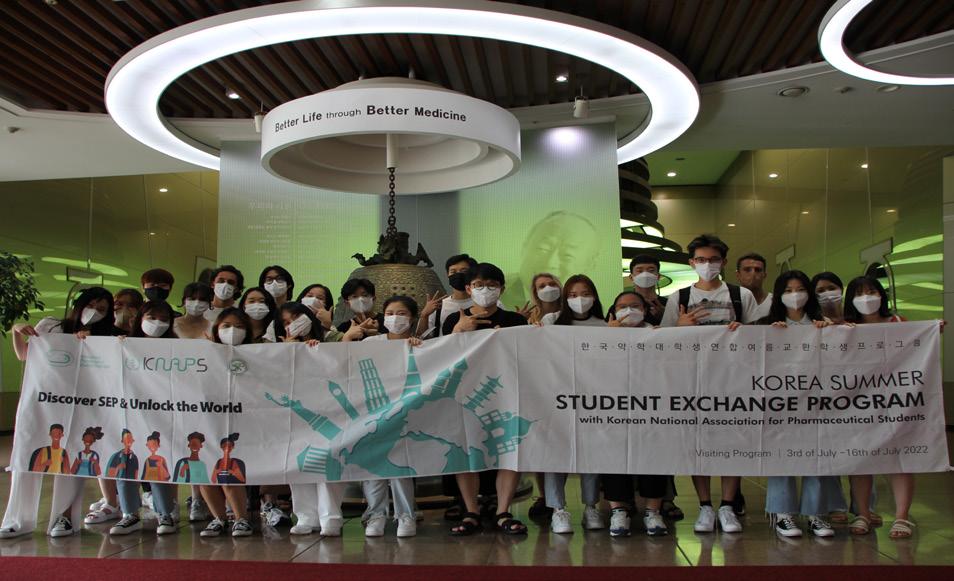
*FIP, INternational Pharmaceutical Federation; UNESCO, United Nations Educational, Scientific and Cultural Organization; WHO, World Health Organization; IPSF, International Pharmaceutical Students’ Federation; APRO, Asian-Pacific Regional Officer

The Mission of KNAPS is:
Quality Improvement in Public Health
Domestic and International Networking

KNAPS engages in various international conferences to broaden its members’ perspectives. It joins the WC (World Congress) held regularly by the IPSF. In 2021, KNAPS successfully hosted the 66th IPSF WC. In addition, KNAPS actively participates in the APPS (Asia Pacific Pharmaceutical Symposium) annually, which is helded for one week to elect the next executive, discuss several topics, vote on agenda, and exchange each other's culture.
National activities of KNAPS, such as NC(National Congress), KPLC(K Pharm Leaders’ Camp), Medical Awareness Campaign and Patient Counseling Event, bring students from the whole country every year. KNAPS also holds a variety of workshops, pharmaceutical symposiums, and several sessions to promote KNAPS and IPSF/APRO. You can visit our website, Facebook, and Instagram for more detailed information.
www.knaps.or.kr www.facebook.com/knapsipsf www.instagram.com/knaps_korea_official www.instagram.com/sep.korea
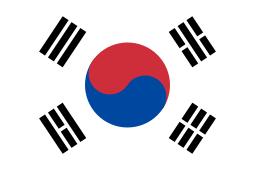
51 million Population 27th most populous country on earth 9 Provinces Capital Currency Languages
Seoul Won (KRW, ₩) Korean
Asia
Republic of Korea is a country visited by approximately ten million international travelers every year. With its long histroy in culture and tradition, the country has a lot to offer to travelers

Both traditional and modern elements of beauty harmoniously coexist in this city. Even though it has history of colonization, South Korea has conserved its legacy. The royal palaces, gardens, and fortresses surrounding Seoul are open to the public. The changing guards ceremony is held at the main gates everyday. Seoul prides on its traditional heritage and natural surroundings while embracing western influences. Skyscrapers have observation decks to take in the panorama of Seoul. River cruises run along the Han. Seoul is bursting with cultural events, performances, sports activities, culinary delights, and bustling nightlife as well.
Shopping malls in special places are open 24/7 so you can shop whenever the urge strikes in Korea. The heart of this shopping explosion is Dong-dae-mun, a district of Seoul which houses 37 shopping centers, 35,000 shops, and 100,000 people working in the industry, even at 3AM. The shops are open from 10:30AM to 5AM the next day.
usage of credit cards with an electronic chip embedded to pay for fares, or transportation-use debit cards that can be bought at convenience stores, and tickets purchased with cash at ticketing machines.
The word "Hallyu", also known as the Korean wave, is a new word that emerged in the 1990s as the influence of Korean culture grew rapidly in other countries. Representative cultural contents of Hallyu include K-drama and E-sports.
The Netflix original series <Squid Game> has ranked first on Netflix's global chart for 29 days after its release on September 17, 2021. It set a record to occupy the first place in all 83 countries where Netflix is served. Traditional Korean children's play, which is used as a survival game in <Squid Game>, is popular through SNS, and the costumes worn by the characters are also gaining popularity in many countries.
The public transportation system in Korea is very advanced. The subway, which is intricately woven like a spider's web, has 10 lines and 330 stations including Seoul and its surrounding areas, making it very accessible. The level of hygiene, comfort, and safety is high. Purchasing tickets and changing subway lines are intuitive, and stop announcements are in English. The entire edge of the tracks in most stations have glass walls to prevent anyone from falling onto the rails. Bus lines are even more intricate than subways. However, that problem can easily be overcomed by installing mobile applications that provide instructions and directions to get to the destination. South Korea has adopted payment systems that allow
E-sports has completely established itself as the mainstream culture of millennials and Generation Z. They enjoy E-sports games through internet broadcasting or SNS platforms. Rather than the Olympics held every four years, there are many people who stay up all night looking forward to the finals of the League of Legends World Championship(LoL). Especially, audiences cheer for LoL pro gamer Faker(Lee Sang-hyeok)'s fantastic mouse movement and creative strategy. "PC bang" culture in Korea may be contributing to the development of E-sports. It was originally used to be an entertainment space where you can simply enjoy playing online games with friends, but it has recently been transformed into a complex cultural space such as a restaurant and cafe offering various cuisines.
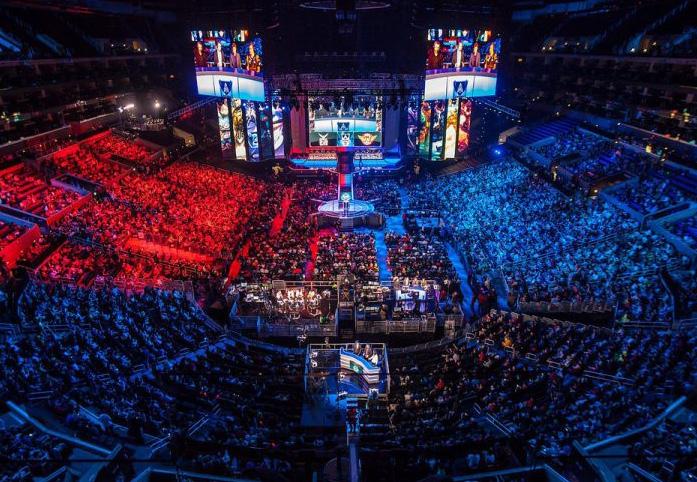
Drug Utilization Review (DUR), one of the domestic healthcare systems, is in force to prevent inappropriate use of drugs since April 2008. DUR, which was benchmarked from the US, aims to protect public health by double checking prescriptions and reducing unnecessary medical expenses to prevent medication accidents. For instance, if a patient sees several doctors, the pharmacist will not know which medication the patient has taken in advance. These circumstances may lead to overdose and cause several side effects. DUR provides pharmacists with information on drug safety organized in 10 criteria, including real time check in contradictions between the newly prescribed drug and the drug taken in advance. As of 2019, the participation rate of medical intuitions for DUR reached 99.8%.
Equipped with advanced management and production mechanism, Korea’s pharmaceutical companies are receiving excellent feedbacks from all over the world
about their high-quality products. Since the very first creation, a product named “Sunpla Injection (cancer treatment)”, in 1999, 29 new drugs have been made in Korea as of March 2018. Furthermore, there are about 20 drug products that have established a foothold in major global pharmaceutical markets including the U.S. and Europe. Korea’s pharmaceutical companies have more than 900 new medicines currently in production which accounts for 4% of the total global pipeline. Korea plans to expand its investment in R&D to boost up the development of new medicines.

Korea is stretching out its power in the global biopharmaceutical industry based on its outstanding biotechnology infrastructure, advanced clinical study, and world-class IT technology. Korea’s HearticellgramAMI (Pharmicell) is the world’s first stem-cell therapy product to gain approval for commercial. Moreover, 4 out of the 8 globally commercialized stem cell therapy products were developed in Korea.

The Han River, which crosses the center of Seoul, is a representative river in Korea. It is a relaxing place, lie down on the grass, have picnic, and take a walk with friends and dogs. There are lots of parks built along the river, so you can ride a bike from park to park and see appreciate the beautiful view of Han River. Enjoy busking performances and take pictures at various photo spots.

Cheonggyecheon is the ecological stream from Gwanghwamun to Dongdaemun. People can take a walk and refresh themselves here. Various events such as lighting ceremonies and marketplaces are frequently held, so it’s worth visiting for travelers.

I t is the first palace in Joseon dynasty, and is the largest and among five remaining palaces in Seoul. You can look deep into the culture and architecture of the Joseon dynasty.

The maze-like Insadong street is a representative street of Korean traditional culture. This is a precious space where old but valuable traditional objects exist in the center of a city. This place has galleries, traditional crafts shops, tea houses, restaurants and cafes.


Lotte World Adventure is Korea’s representative theme park featuring various attractions that provide you the new and pleasant experiences. Lotte World Tower with 123 floors and 555m heights is the world’s 5th tallest building. The Seoul Sky Observatory is located at the top of the Lotte World Tower and is the place where you can take in a gorgeous 360° view of Seoul.
Located in the center of Seoul, Namsan Mountain is one of the most popular nightviewing spots. In particular, it is attractive to see the panoramic view of Seoul along the Namsan trail. You can use a cable car, and there are locks of love at the Namsan Seoul Tower observatory in Seoul, making it a perfect place to date for couples.

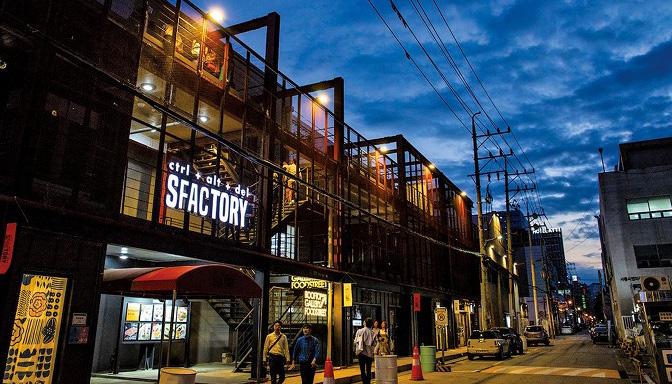

This is Seoul‘s the busiest area and the best place to get a real inside look at modern Korea. And this is a crucial transfer point between two subway lines and buses to all parts of Seoul. The entire area is densely packed with companies, restaurants, cafes, bars, clubs and fashion stores.
Seongsu is a popular neighborhood among young Koreans in recent years. Seongsu used to be an area lined with small factories. But nowadays, an array of cafes and restaurants placed in repurposed factories and old residential buildings make this place special. Most notable attraction in Seongsu is Seoul Forest which is a beautiful public park and great place to walk and spend time away from touristy areas for an afternoon.
Memorial museum is filled with poignant exhibits, war memorabilia, art works, and military equipment that make this a perfect place to learn about Korea’s history of war, most notably with North Korea. If you want to know more about the division of Korea, do not hesitate to visit. There is also a recorded guide headset at the entrance for you to pick up and listen while strolling around.

Busan is the representative city of Korea together with Seoul. Busan is located at the southeastern end of Korea and is also Korea's No.1 port city. There are many good beaches and tourist attractions, so it is a tourist destination that even Koreans living in other regions frequently visit. Busan's slogan 'Dynamic Busan' shows well the atmosphere of Busan people who are open and dynamic.
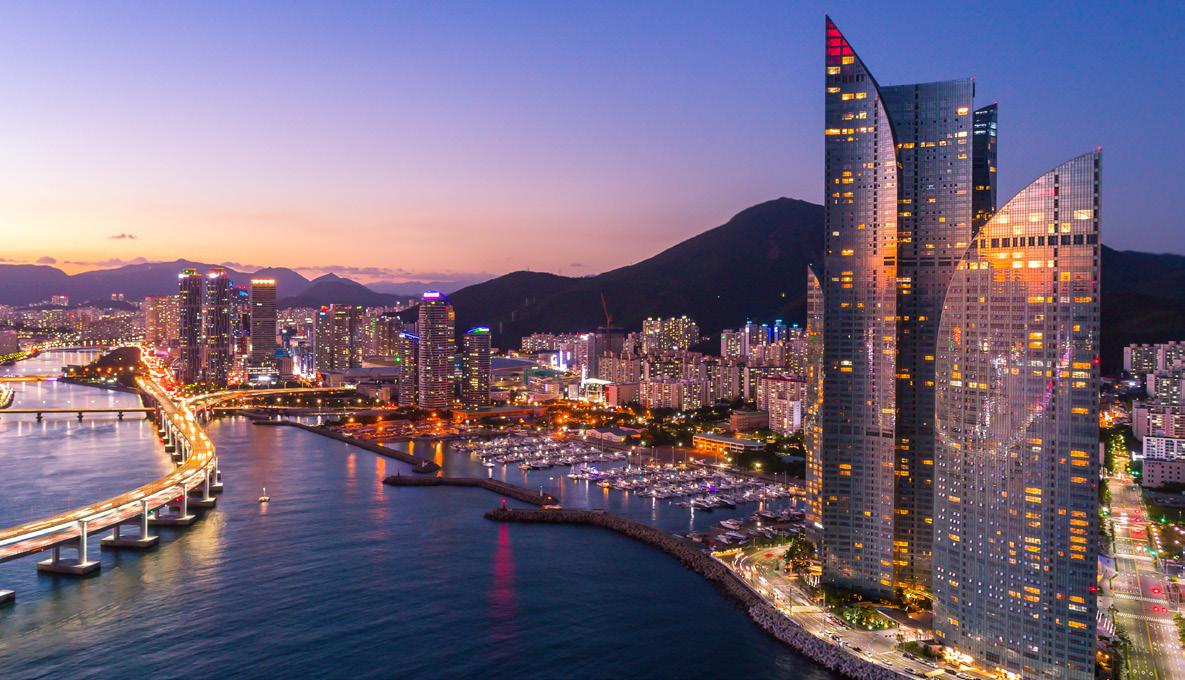
Haeundae Beach is a seashore located in Busan and is often considered as one of the most famous and beautiful beaches in Korea. You can walk on a sandy beach looking at the wide sea and can take beautiful pictures. Also, it is the place where many festivals are held. Especially, every fall, the Busan International Film Festival which is the largest film festival in Asia is held in the cinema center of Haeundae Centum City.

Gwangan bridge stretches over 7.4km from Suyeong-gu to Haeundae-gu and is the longest bi-level bridge over the ocean in Korea. In addition to providing a quick way to get around, the bridge offers breathtaking views. Equipped with thousands of LED lights, the bridge presents a beautiful night lighting exhibition that changes with the seasons.
Haedong Yonggung Temple is situated near the sea, unlike other temples in mountains. Waves of the blue sea slash the rocks right under where you can see spectacular sunrise. And while you enjoy the roar of waves and the beautiful sunrise, you will forget about yourselves and be absorbed into the world of wonder.

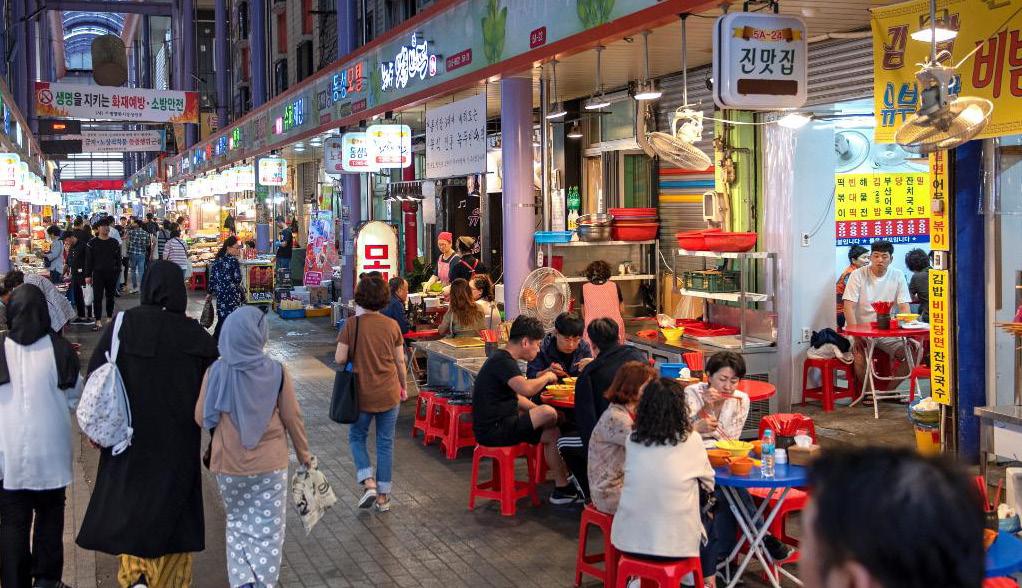
The story of this village begins with the difficult life of the refugees of the war of 6.25 (also known as the Korean War) and still retains a trace of the history of the people of Busan. It has a nickname “Korean Santorini Island” because of its hills neatly lined with terraced, pastel-tone houses.

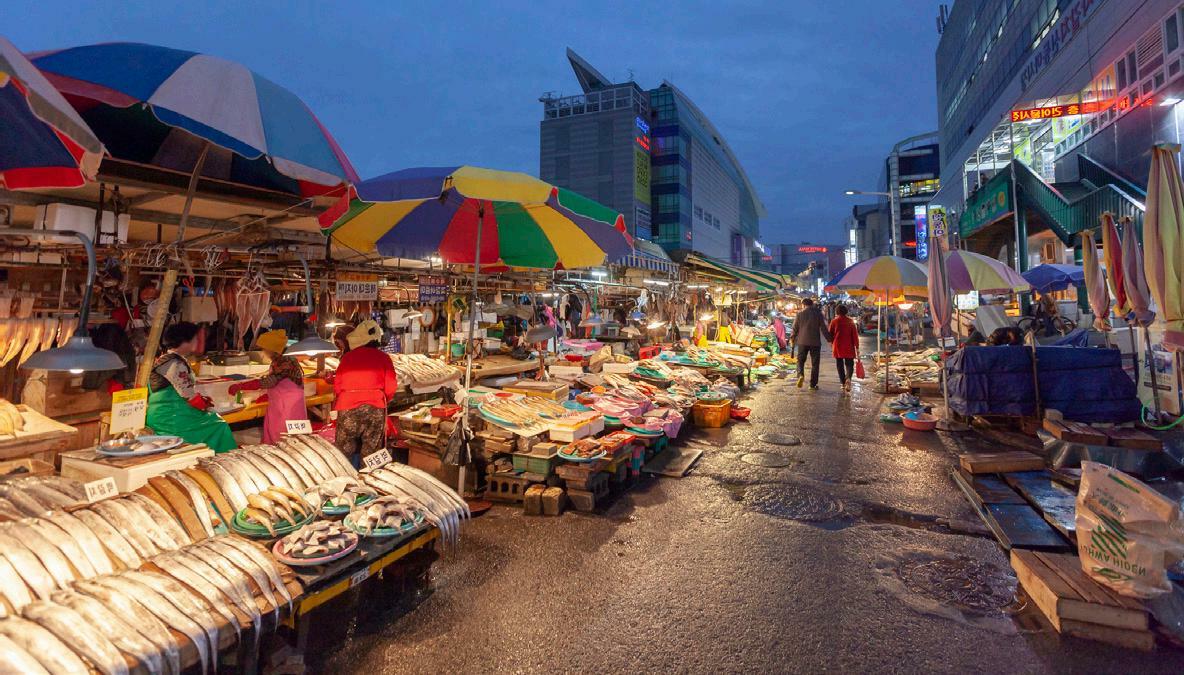
Busan International Market is the representative traditional market located in Busan. After the Korean War, the market flourished by distributing foreign goods, and it is now keeping its tradition and forming a huge commercial supremacy. There is everything but the kitchen sink! Many travelers visit to eat various foods such as Bibimdangmyeon and Yubu pocket and to see lots of attractions.
Jagalchi market is one of the best places when it comes to live fish markets. Every type of creature that lives in the sea whether they are large and strong or short and slim can be found here. It might make you feel like you are in an aquarium where the sea breathes in and out for 24 hours. You can pick out what you would like to taste by pointing at the water tanks filled with fresh seafoods. If you want to try best raw fish in Busan, visit Jagalchi market!


Gyeonju was the capital of Silla, a country that controlled the southeastern part of the Korean Peninsula for 1,000 years, 2,000 years ago. Gyeongju is like a huge museum because there are many unique Silla remains and Buddhist remains. It is fun to look around many royal tombs and beautiful buildings. Gyeongju is also famous as a city where high school students in Korea go on a lot of field trips!
They are ancient Buddhist relics dating back to the Silla Dynasty. Seokguram is a stone cave constructed artificially using granite, and Bulguksa is a wooden building that shows the essence of ancient Buddhist architecture. These national treasures were registered as world heritages by UNESCO and show the antique architectures and beautiful landscapes.
This building is the oldest astronomical observatory in the East and used as observing the sky during the Silla period. It may have been used to observe the movement of planets and to observe astronomical phenomena for the purpose of prediction of the future of the nation. As a landmark of Gyeongju, it adds to its beauty at night. There are lots of traditional cafes nearby, and it's a highly recommendable place for enjoying a cup of tea.

I t is the secondary palace site of Silla royal palace. It is used as a place of holding feasts when the nation was in a happy occasion or when they received rare guests. It is famous for its beautiful nightscape. The most impressive scene is the reflection of the palace reflected by the moonlight on the pond.

won UNESCO-accredited titles such a Biosphere Reserve, World Natural Heritage, and Global Geopark, Jeju is a world renowned treasure island worthy of worldwide attention and conservation.



Hallasan Mountain has the title of South Korea’s tallest mountain with a height of 1,950m above sea level. The mountain is surrounded by 360 parasitic volcano and that presents a unique view. With a repository of subtropical, temperate, and subarctic vegetation according to is altitude, Hallasan Mountain is registered as a UNESCO World Natural Heritage and thus receives special protection.
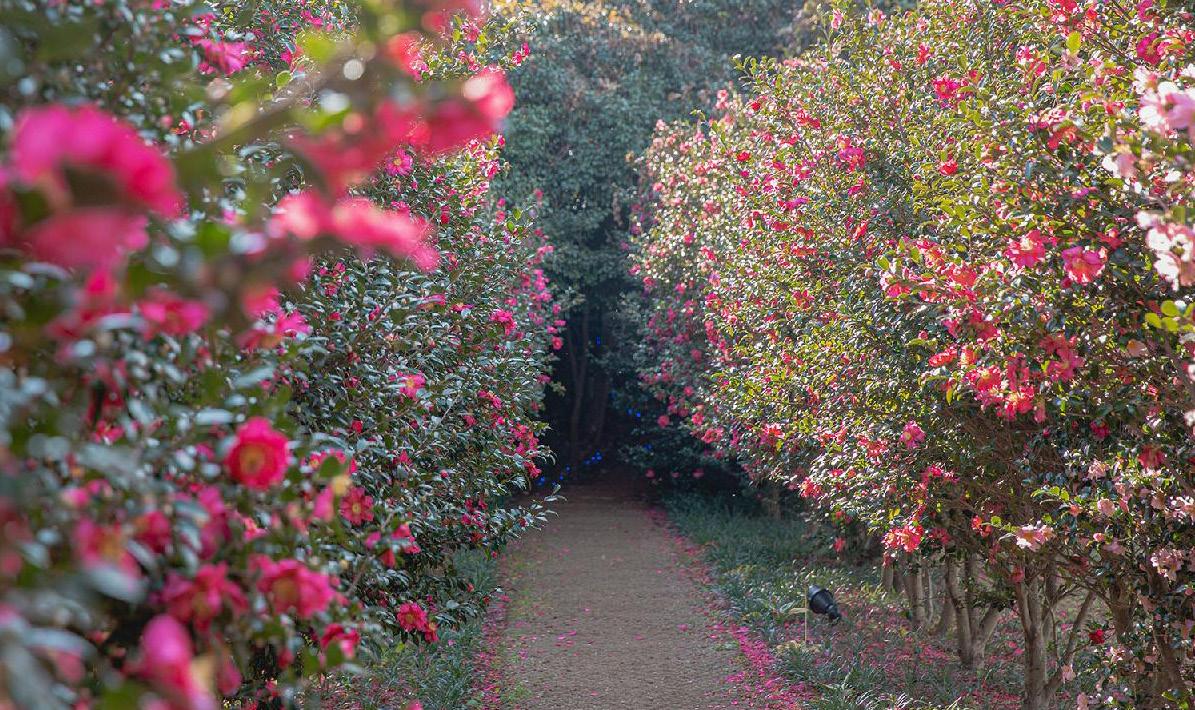
Camelia Hill is the largest camellia tree arboretum in the East, with 6,000 trees, 500 species of camellias from 80 countries, forming a dense forest. Beautiful and colorful flowers have a variety of scents, giving each step a subtle and refreshing fragrance. With the good photographic props and picturesque nature in Camelia Hill, you can take beautiful photos here.
Sangumburi is a crater designated as Natural Monument No.263. Gumburi is a Jeju term for volcanic crater. It is one of the 360 satellite cones of Hallasan Mountain but unlike other parasitic volcano, it has a large crater, which is unique in that it is relatively large compared to the shape of the mountain. It is also a ‘crater botanical garden’ where a variety of rare plants exist in one place.
This tuff cone is formed when an underwater volcano erupted in the middle of the ocean. Seongsan Ilchulbong (Sunrise Peak) was designated National Monument No. 420 in 2000 and a UNESCO World National Heritage site in 2007. Named for the spectacular sunrise on it’s top, Seongsan Ilchulbong is inspiring to many people.
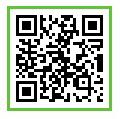
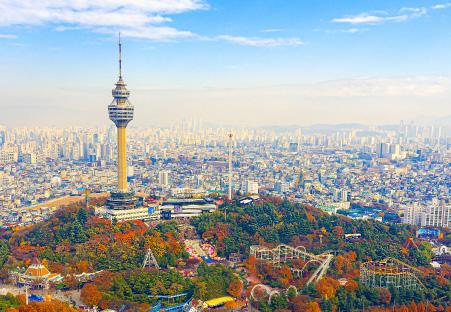
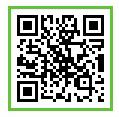

In 2020, the Korea Tourism Organization’s Youtube channel “Imagine your Korea” uploaded a video of the “Feel the rhythm of Korea” series. These videos became a hot topic by introducing cities far from Korea’s representative tourist destinations along with traditional Korean music that are contemporarily reinterpreted by the Korean band named “Inalchi”. The cities introduced in Season 1 include Seoul, Busan, Jeonju, Andong, Mokpo, Gangneung, etc., while Season 2 includes Gyeongju&Andong, Daegu, Suncheon, Seosan, Busan&Tongyeong, Yangyang&Gangneung, and Seoul.

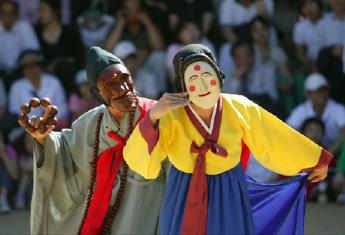
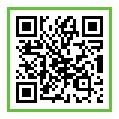
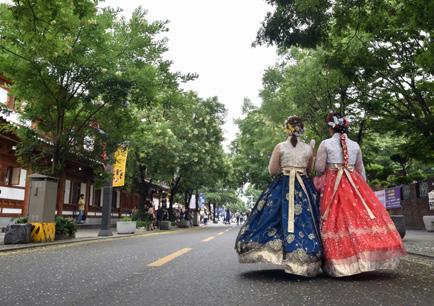

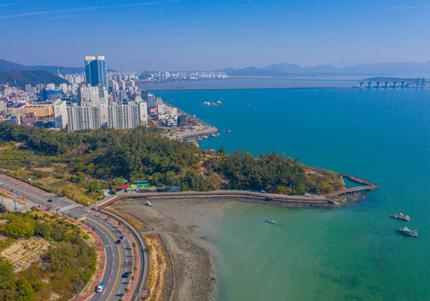

불고기
Bulgogi; marinated beef barbecue
Bulgogi is a juicy, savory dish of grilled marinated beef. It is incredibly tender beef that has been marinated in a sauce of sweet soy sauce favors that’s often cooked in a pan with sliced onions and other vegetables. Pour the sauce on some rice and try it to savor this amazing sauce.

김치
Kimchi; chili pickled vegetables
Technically, kimchi is a kind of banchan, all sorts of side dishes that are served together with the main dish. Kimchi is served with almost every meal you can find! It is a fermented vegetable typically made from cabbage, but many others are made with different vegetables such as radishes, green onions or cucumbers.

떡볶이
Tteokbokki; spicy rice cake
Ddukbokki is a representative of street food in Korea. There are many varieties of ddukbokki. Some are red and spicy, some are brown and salty, some are boiled and while others are fried. Koreans fuse ddukbokki with other foods like cheese, noodles, and meat. When it comes in a boiling pot, the marshmallow-like rice cakes will just melt in your mouth.
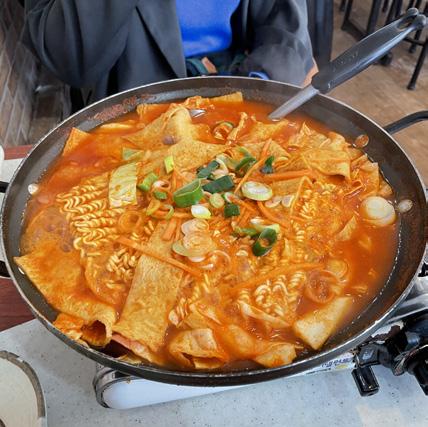
Korean BBQ
Korean BBQ is wonderful to enjoy with a group of friends. Samgyeopsal and Galbi are often the favorites. Dip your freshly grilled meats in Ssamjang (a thick, sweet and spicy bean paste), and then wrap it in lettuce with kimchi, grilled slices of garlic and onion. You’ve got a favor to cherish there.
비빔밥
Bibimbap; mixed rice

First of all, you will be surprised at the colorful look of it and then at the unique flavor of each ingredient dancing in your mouth. It is rice topped with seasoned vegetables, red egg, beef, mushrooms, soy sauce and chili pepper paste. Just before eating this beautiful dish, stir it to blend all the flavors together!
삼계탕
Samgyetang; ginseng chicken soup

A Summer specialty! Samgyetang is one of Koreans’ favorite energy source in summer. We put chicken and garlic, rice, scallions, ginseng, jujube all together in a pot and boil them together. It’s considered a summer-bearing food traditionally.
치킨
Korean style fried chicken

Korean style fried chicken is one of the most popular midnight food among Koreans, and it goes great with cold beer. We call it “Chimaek”(chicken and beer). Wondering what is so special about a fried chicken? The combination of thin, crispy crunch with the juicy, tender chicken meat is fantastic. It also comes in many different favors and they will never fail you.
잡채
Japchae; stir-fried glass noodles
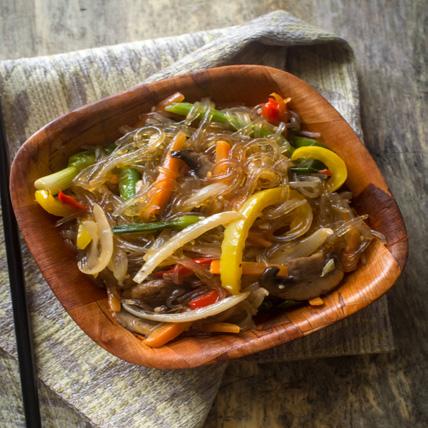
Japchae is a traditional Korean noodle dish that is popular among Koreans of all ages. It is made from glass noodles, chopped vegetables, beef, sesame oil, sweet and savory sauce. Thanks to the glass noodles, it has very soft yet slightly chewy texture. When looking around traditional markets, you will find it hard to go-by without trying it.
and go like a burger except it’s much healthier and comes in a ton of varieties.
Meat and vegetables are wrapped in a thin layer of rice and a sheet of dry seaweed. Either when you’re short on time or going on a picnic, kimbap will be a great choice. Try kimbap with tuna fish, cheese, cutlets, or even samgyeopsal.

호떡
Hoeddeok; sweet syrupy pancakes
One of the best winter desserts. It looks like a Western pancake, but once you take a bite, you’ll find a mixture of cinnamon, honey, brown sugar, and small pieces of peanut inside. A piece of Hoeddeok is never enough. You’ll be craving for another.

빙수
Bingsu; shaved ice
It’s perfect for a hot summer day. Normally bingsu is refreshing whereas shaved milk ice is much sweeter, softer.
The traditional version is the one with the red bean paste but chocolate or green tea flavored bingsu is also very popular along with the ones with fruit toppings
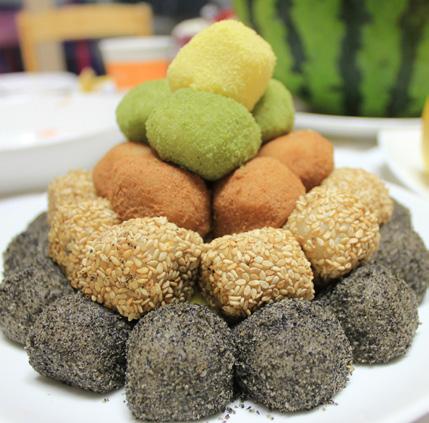
떡
tteok; rice cake
In Korea, we mainly consume rice rather than wheat, so there are many kinds of rice desserts. Rice cake is one of them. We strongly recommend trying special rice cake called songpyeon, which is made to wish for a good harvest on Chuseok (추석; fall harvest holiday).
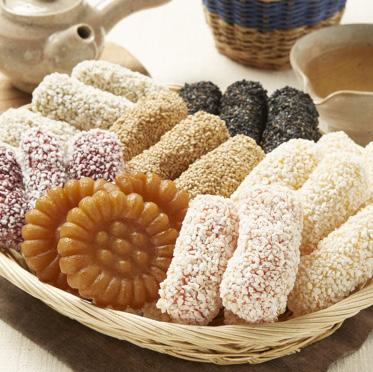
얼린
홍시
Frozen persimmon
Persimmon itself is one of the most popular fruits in Korea but it gets even better when it’s frozen. This sweet and refreshing sorbet is the ultimate dessert that is a fantastic alternative to ice cream. It’s also served in many restaurants for dessert.

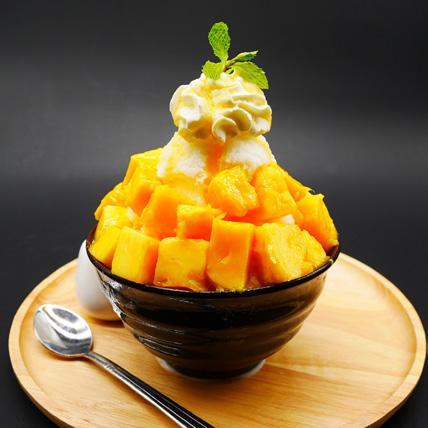

한과
Hangwa; traditional Korean confections Hangwa is a general term for various types of traditional Korean confections. It has been used in traditional ceremonies such as weddings, Lunar New Year day or Chuseok(추석; fall harvest holiday). These days, hangwa is also available at some coffee shops and tea houses, so you can find it easily.
배, 참외
Asian pear, Korean melon Have you tried an Asian pear? It’s nothing like a Western pear. It’s super juicy and the texture is crispy, almost like a watermelon, with a light and sweet taste. Also, Korean melon is similar to other types of melon except that you normally eat the seeds as well because that part is the sweetest bit.
소주
Soju
The national drink of Korea which tastes like watered-down vodka. It is drunk out of small glasses and many Koreans enjoy soju mixed with other drinks like beer, tonic water and sprite. One interesting fact is that Koreans don’t pour their own glass and it’s good manners to pour the other person a glass.
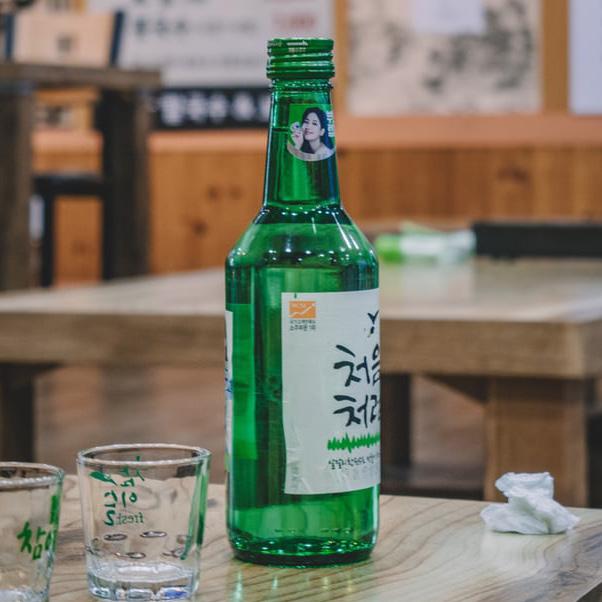
막걸리
Makgeolli
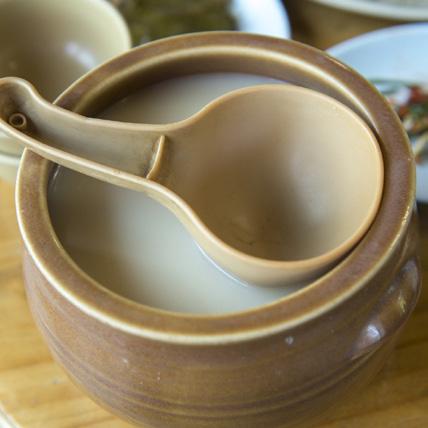
Makgeolli is a traditional Korean rice wine that had been beloved by farmers. Nowadays it is the most popular traditional alcoholic drink and it’s a milky and fizzy drink with a bit of chalky texture. It goes perfect with a crispy pajeon (파전; spring onion Korean pancake) which is a kind of Korean pancake (전), fried pancake made with our and eggs.
식혜
Sikhye; sweet rice punch
Korean traditional drink for dessert, which is made from rice. Fermented rice makes the drink sweet, even without adding any sugar. Most of the Korean drink sikhye at a Korean spa (찜 질방; jjimjilbang). It relieves your thirst effectively and gives you fun texture with rice just like bubble tea.



























Since 2011, Korea had adopted a 2+4 years system to raise professional pharmacists. Students are qualified to apply for pharmacy school when they spend 2 years in general university and take PEET (Pharmacy Education Eligibility Test). During 4 years of education in pharmacy school, students learn from basic pharmaceutical sciences to various pharmacy skills through Pharmacy practices. However, from 2022, the previous system is supposed to be changed to an integrated system called the six-year system and 3rd year high school students can apply for the college of pharmacy directly.
Seoul 8 schools
Gangwon 1 school


Gyeong-gi & Incheon 8 schools

Gyeong-sang 8 schools







Chung-cheong 4 schools Jeolla 7 schools
Jeju 1 school
To major in pharmacy, students must had completed at least two years of an undergraduate college program, passed the Pharmacy Education Eligibility Test (PEET) and the curriculum in each individual college of pharmacy for four years. The system is called the (2+4) year system. Under this system, students are given more freedom to make mature decisions about their majors and occupations after graduating from high school, and colleges of pharmacy are able to accept students with the appropriate level of life experience and aptitude who have completed two years in an undergraduate program in a major or college other than pharmacy.
However, from 2022, admission is possible from the first year. The system has been converted to an “six-year system” that selects high school graduates as freshmen. Therefore, 3rd year high school students can enter the college of pharmacy by passing the college entrance system without taking PEET.

The previous system made students in the college of Natural Science(sometimes including other majors) to drop out of their existing majors and move on to the college of pharmacy. It was pointed out that these decisions could increase abnormally high ‘percentages of dropout students’ and hinder development of the college of Natural Science.
However, the new system can have lots of advantages. First, It can decrease the percentages of drop out in previous majors. Secondly, It can enhance the professionalism of pharmaceutical professionals. There were difficulties in major education due to the lack of connection between 2 year education and 4 year pharmacy education such as differences in academic ability after transfer. Lastly, it can reduce social costs such as private education expenses. Previously, the time and economic costs were excessive due to long-term PEET preparation. According to the data of the Korea Pharmaceutical Education Association, the preparation period is about 6-18 months, and the cost is about 10 million won. It is expected that the new system can curb the costs and time. Presently, In consideration of the graduate vacancy caused by the transition, the current 2+4 year system will be implemented until 2023 year.
National Licensing Examination to become a registered pharmacist
From 2015 onward, it was reorganized into four subjects : Biopharmacy, Industrial pharmacy, Clinical and Practical pharmacy, and Health & Medicine Regulations. Pharmacist license examination consists of 350 problems(1 point is distributed to each problem).
To pass the exam, more than 60 percent of the total points of all subjects and score more than 40 percent in each subject is needed.

As a result of the transition to the six-year system, the proportion of clinical pharmacology in the pharmacist license examination has also expanded. The total number of problems related to clinical pharmacology is 104, which is 29.7% of the total.
Test Subjects No. of items
1st Biopharmacy 100
2nd Industrial Pharmacy 90
3rd Clincial-Practical Pharmacy1 77
4th Clinical-Practical Pharmacy2 / Medical Health Legislation
83
(*tentative schedule)
KNAPS introduces Visiting Programme which provides the best opportunity for the incomers to experience every corner of Korea in both pharmaceutical and cultural aspects. Any IPSF member who is enthusiastic to learn about Korea do not hesitate to apply for this program!

- 2022 KNAPS Summer Exchange Programme
Visiting Programme Agenda
Date Morning Afternoon
3rd of July
Welcoming Party
4th of July National Forensic Service
5th of July
6th of July
NHIS Community Pharmacy
Seoul National University Hospital
7th of July
8th of July
9th of July
Seoul N-Tower
Korea Pharmaceutical and Bio Pharma Manufacturers Association (KPBMA)
Handok Museum of Medicine and Pharmacy
COEX, Aquarium, Temple
10th of July 1 Night 2 Days Trip
11th of July
12th of July
13th of July
Boryung Pharmaceutical
14th of July K-FDA
15th of July
16th of July
Chong Kun Dang Pharmaceutical Company
Sight seeing
Korean Folk Village
Korea National Enterprise for Clinical Trials
Korean Association Against Drug Abuse (KAADA)
Farewell Party
Students will visit various pharmaceutical institutions such as global pharmaceutical companies, cosmetic industry, major university affiliated hospitals, community pharmacies, and public organizations. You can have a close look at Korea’s health care system, cutting edge technology, pharmaceutical community service, and medical industry. Moreover, listening to other Incomers sharing each other country's health care system and pharmaceutical characteristics will widen your view. These experiences will eventually affect you when deciding your career. Join KNAPS SEP Visiting Programme and dream what kind of pharmacists you want to be.


We visited NHIS(National Health Insurance Service) and NFS(National Forensic Service) to learn about the public organizations in Korea. NHIS is responsible for the management of the national health insurance which protects the nation from disease and covers the long-term care insurance. In addition, NFS has played a role in providing support during the initial phase of criminal investigations and resolving unsolved cases. While touring various places such as autopsy and examination rooms, we were able to experience what the institution conducted.
Also by visiting The Korean Association Against Drug Abuse(KAADA) and KoNECT, we could find out more diverse roles of the institutions. Lots of pharmacists carry out comprehensive projects for prevention of illegal drug use and they also play an important role in KoNECT as clinical trial support experts.
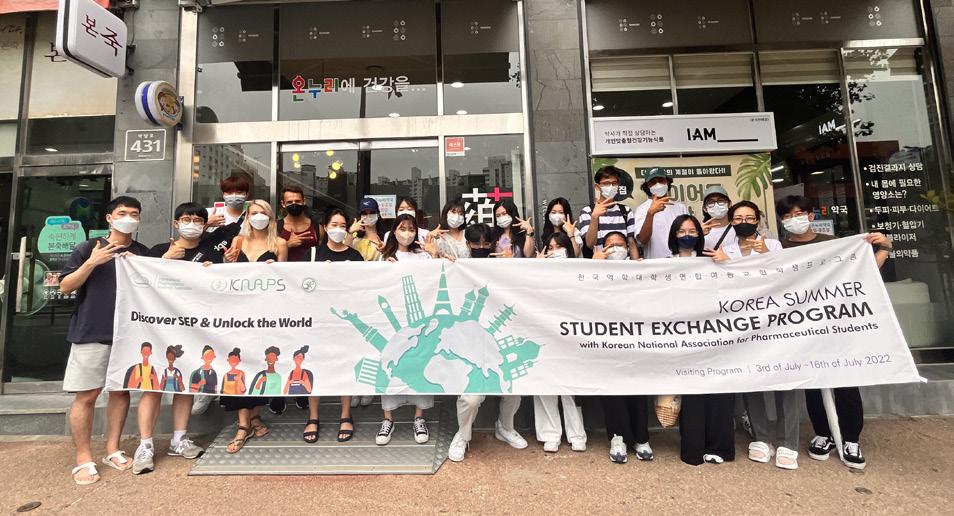

At Seoul National University Hospital, we had a tour of the entire hospital with the head of the pharmacy department. During the tour, we could experience the automated system to allocate prepared drugs to each ward, hospital facility and system to maintain efficient and safe pharmacists offices, and Korea's most developed health care system.
By visiting the factories of Boryung pharmaceutical company, we could find that they consist of many smart-plant that have the most cutting-edge drug manufacturing technique with automated processes. We were also able to explore all the manufacturing facilities and drug warehouses. Additionally, We visited Chong-Kun-Dang pharmaceutical corpation. Headquarters and Handok Museum of Medicine and Pharmacy, as part of a historical survey of the Korean pharmaceutical industry. We had a closer look at traditional Korean medicine and the development of the pharmaceutical industry over the past 100 years.
We visited a community pharmacy in Anyang, and learned about popular health care products in Korea, OTC preparation and sales of ETC. We learned not only about dispensing drugs, how to store narcotics but also about the sales structure of pharmacies, application of insurance, and medication counseling.


During the SEP visiting programme, KNAPS SEP team will always be around you to help you travel to every corner of Korea and experience true Korean culture.
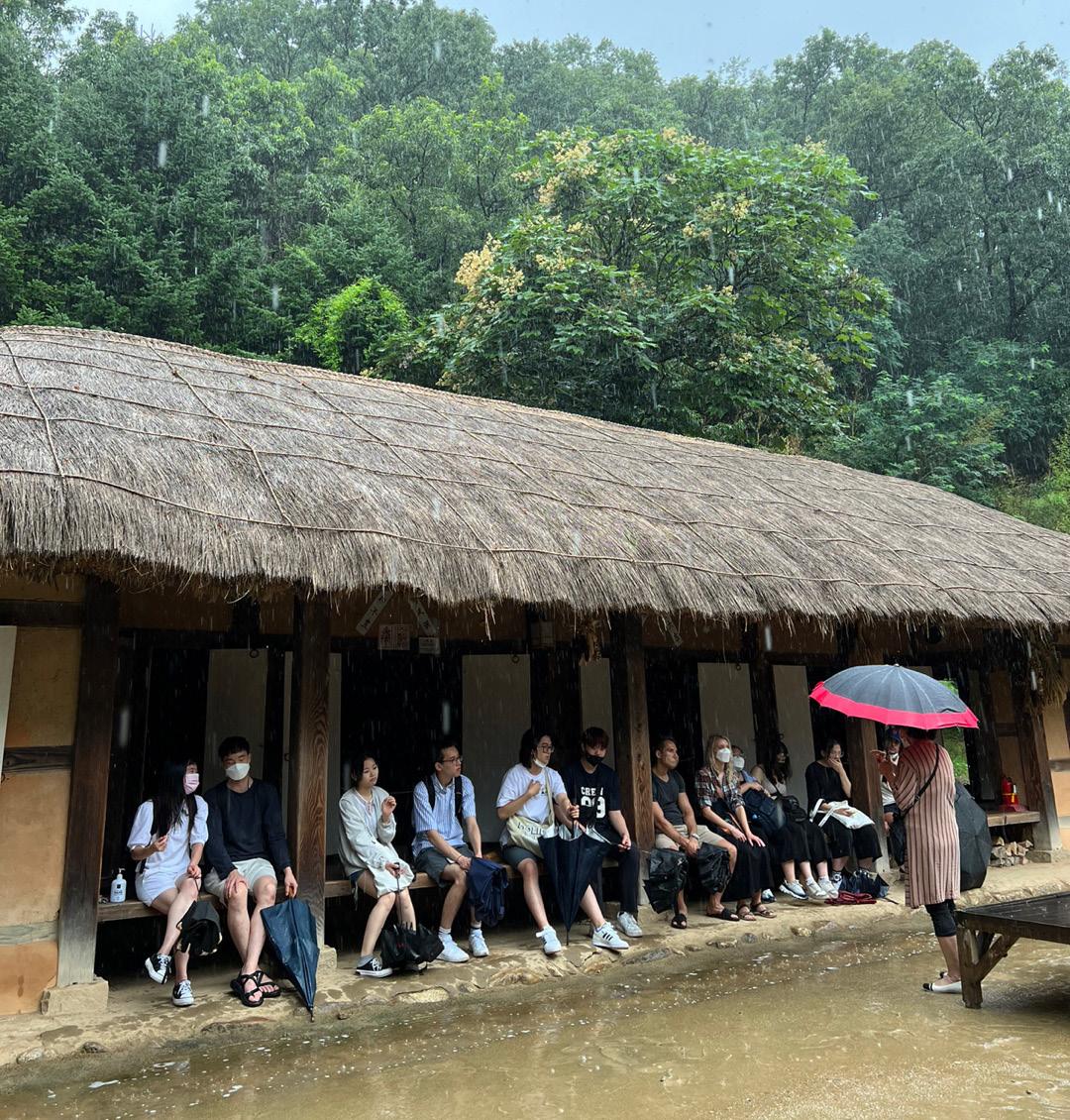
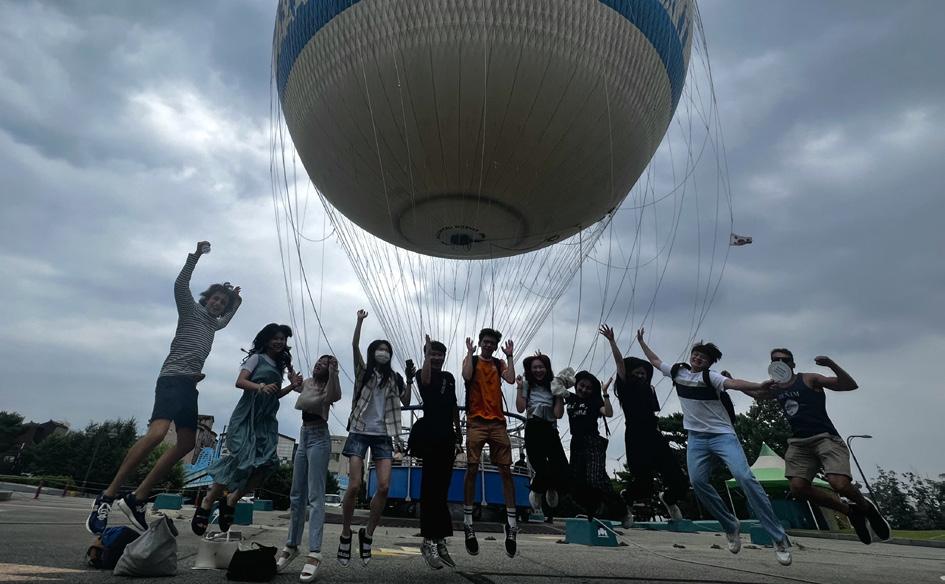
For the very first program, we have a welcome party with all KNAPS SEP team members and Visiting program students. Exchange students have a chance to learn simple basic Korean, and other useful tips while staying in Korea. Also we have ice breaking games and a traditional Korean dinner to learn more about each other.

To understand a country, knowing the tradition of that country is important. To get a closer look at Korea, we visited many beautiful traditional landmarks. At Korea folk village, we could enjoy Korea’s traditional games, dance and music. We enjoyed all types of local food that you cannot find outside of Korea at the Kwangjang traditional market. We made our own Korean traditional masks which are called a Hahoemask and showed them to other members. Because of the rain, we could learn the cultures of folk villages from a guide under the traditional roof. It was one of the best ways to feel the quiet and still atmosphere in Korea.
In Korea, there is a special culture at the University. All the students of the same major go on a 1 Night 2 Day trip together very early in the semester. Through this trip, We have a short break from our studies and get to know each other better. In the summer of 2022, we went on a trip to Suwon, a beautiful city 1 hour away from Seoul. At first, we boarded a helium balloon and looked down at Suwon city. It was very spacious and had a different feature compared to Seoul. We also watched a baseball game and it was really fun because we cheered together and could eat delicious food at the same time.
After visiting a pharmaceutical institution every day, you can experience all kinds of Korea's delicious cuisine every dinner. KNAPS SEP staff members are willing to share their favorite dining places all around Seoul. Since Seoul is a city that never sleeps and has very convenient public transportation, you can experience all the beautiful corners of Seoul.
*Every event is completely organized by the KNAPS SEP team, and every year the program details differ.
 Robert Cendula (SPSA, Slovakia)
Robert Cendula (SPSA, Slovakia)
Though Korea was the third place I visited as an exchange student, it was the country that gave me the best experience ever. It took me hard time arriving at Korea due to the change of flight schedule. However, hosting students from SEP took care of us sincerely and I’m grateful for their care throughout these period. They had us experience Korean traditional food, drinks, sports events, cultural and historical programs by visiting tourist attractions and vacation spots. Also, I was able to visit pharmaceutical institutions where I could learn how public and hospital pharmacies work in Korea. SEP in Korea was the best decision I made in my life. It is difficult to summarize all experiences and feelings in such a short report and to choose the most memorable experience. I hope that I could provide hosting students from SEP in Korea with ‘visiting program‘ in Slovakia if they visit my country. Thank you Korea!

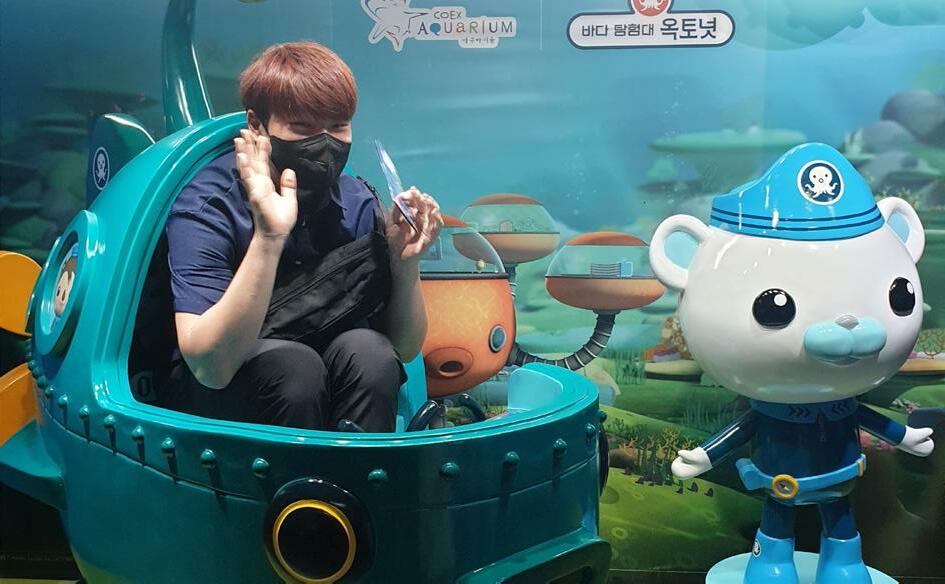
This summer, I had a great time in Korea with the help of staff members. Throughout the program, it was great to have a chance to compare the pharmaceutical industry between my own country and Korea. Among many other programs the staff had prepared for us, I would say that visiting the community pharmacy was inspiring the most. It was impressive to talk about the different roles that pharmacist played during the COVID-19 pandemic. Also, I was happy to experience daily lives of Korean college students.

Visiting Chong Kun Dang and the community pharmacy was the most memorable experiences I had in this program. What I like the most in CKD was making my own traditional incense which made me think back to this summer. Also, I liked visiting the community pharmacy because I had a chance to talk with other students and get to know them better. Thanks to the KNAPS staff members, I could also experience the real Korean cultures including karaoke, café, photobooths and many others. I will never forget this summer where I made new friends and memories.
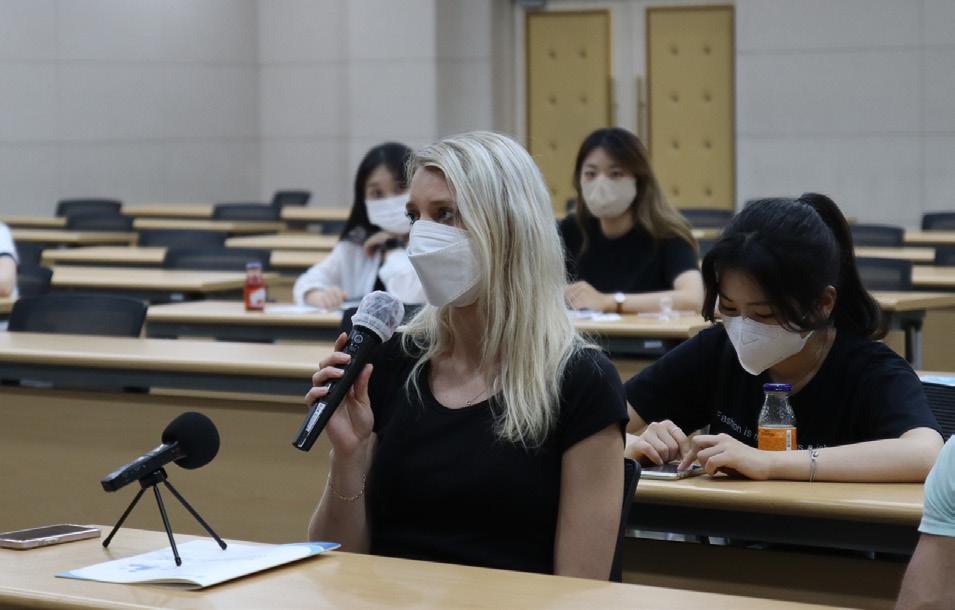

 Vania Aileen (BEM FF UI, Indonesia)
Vania Aileen (BEM FF UI, Indonesia)
I was extremely happy during the program partly because I got a chance to meet and know incredible pharmacy students from other countries in person and partly because of the whole schedule of the program. When I signed up for SEP, I chose South Korea and KNAPS right away as the association that accommodated me because they offer so many different experiences in all pharmaceutical fields. I feel grateful getting this opportunity to learn more about pharmacy and also get the real experiences about how industrial, clinical, community and other pharmacy institutes or companies run in Korea. This was my first time going to Korea and I find this country very interesting and pleasing to explore, especially for the food, places and architecture, and scenery. South Korea is a comfortable, safe, fun, and travel friendly country. We can leave our bags or other belongings somewhere and then come back again. The Korean people are also kind, friendly, and helpful particularly all the SEP Staffs.

The visiting program held by KNAPS was perfectly balanced with educational and cultural programs. It provided great time to learn while having fun. The programs were planned out throughout the day from morning to night which made my travel journal 160 pages long only in 2 weeks. The best part was being able to make foreign friends. I really appreciate the work of Korean SEP staffs, and fell in love with Korea.
I got to participate in the SEP Visiting Program due to the suggestion of my colleague. I had a wonderful and meaningful time in Korea. Thanks to the preparation of Korean SEP staffs, I was able to visit Korean pharmacy, hospital, pharmaceutical companies, and institutions. Besides these, I also attended interesting events that the staffs planned such as welcome party, social dinner, bowling, trip to Suwon etc. The most exciting experience was the picinic at Han River. I tried out plenty of Korean snacks and drinks. Also I got to share thoughts about life with other incomers. This was an unforgettable moment when I felt connection with friends from other countries. I strongly recommend you this program. You will never regret it!
There are vast laboratories of the College of Pharmacy where they are carrying out various pharmaceutical research. We offer you the opportunity to be assigned to do research in laboratories about your area of interest. You will conduct an experiment according to the professor’s instructions. Through this research program, you can deepen your knowledge of the pharmaceutical area and experiments.
In 2020 and 2021, despite the COVID-19 situation, a total of five students have visited and taken their role in the research program. In 2022, eight students participated in the research program. In addition to research opportunities, they also had time to enjoy Korean culture in the evening under the leadership of the KNAPS staff. The number of people selected for the Research Program may vary depending on the circumstances of each laboratory every year.
*The specific institution and event can be changed at any time.

*There will be no financial support, so incoming student must bear all the cost.
Seoul Lab of Medicinal Chemistry


Gyeong-gi
Seoul National University

Ewha Womans University
Kyung Hee University
Sookmyung Women's University
Lab of Molecular Pathology
Lab of Molecular Immunobiology
Lab of Medicinal & Organic Chemistry

Lab of Natural Product Chemistry
Lab of Molecular Neurobiology Sungkyunkwan University
Gyeong-gi Seoul
The time when I got to know about Korea was when I had some SEP students from Korea as a SEO in Spain. From their tales about the beauty of Korea, I had gotten some huge curiosity which finally led me to apply and come to Korea for an internship. I can definitely say I had a wonderful August in Korea, 2021. I had an internship at Kyung Hee University, in the Lab of Medicinal Chemistry which was very huge, well organized, and well located which was a perfect environment for an internship. I had a great time learning about synthesis of new compounds with my kind and friendly lab members who taught me about many things in the pharmaceutical field. Also, I could make good friendships with KNAPS staff and exchange students from other countries for internships. Good vibes, laughs, foods, plans, and everything made my time in Korea 1000 times better than I could ever imagine. I was a bit worried about COVID-19 situation before coming to Korea, but I had a wonderful time and learned fully enough which made my concern useless. I highly recommend anybody interested to apply for it. It will be an unforgettable experience.
I always wanted to visit Asia and experience that kind of culture. I was thinking a lot which country would be the best for me and I decided that would be South Korea. South Korea was the country having the perfect match of traditional and modern. It wasn’t that easy to get there because of COVID-19. Getting a visa and 2 weeks of self-quarantine in South Korea was a big challenge, but those obstacles were not enough to go beyond my dedication and wish and I made it! From this point of view, I can say that all this effort I made definitely means a lot to me. Thanks to KNAPS SEP staffs and SEO, I had a chance to be a part of a research program at great Ewha University, to learn many new skills I did not have a chance to learn before in Serbia. And I also wanted to say thanks to professor Hwang and all lab members for helping me. There is no more valuable thing than making new friends and meeting new cultures. This is how we feed our souls and minds. After everything I experienced in Korea, in my heart there is only a wish to visit this beautiful country once again and meet these wonderful people. Because each one of you will have a friend in me for life.

Let’s start with the year 2020. When it became January 2020 I thought I have to go abroad in my student life, which is sometimes difficult with our major. I really wanted to join this year's Student Exchange Program (SEP) in South Korea and was motivated to try my best to enter the research program. It seemed the best organized and well managed, so I wanted to give it a try. It somehow worked out, but then Corona happened. A lot of things changed very quickly during this time and I was uncertain if I would actually go this year or not. Through all these difficulties, the Host Student Exchange Officer (SEO) was always there for me and I came forward to her with any concerns I had. The visiting program students and all the other research program students got cancelled, so this year it would be just me – an adventure began…
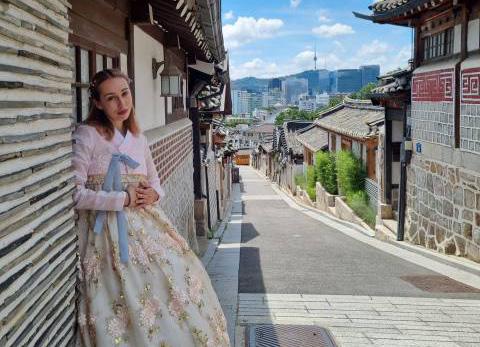

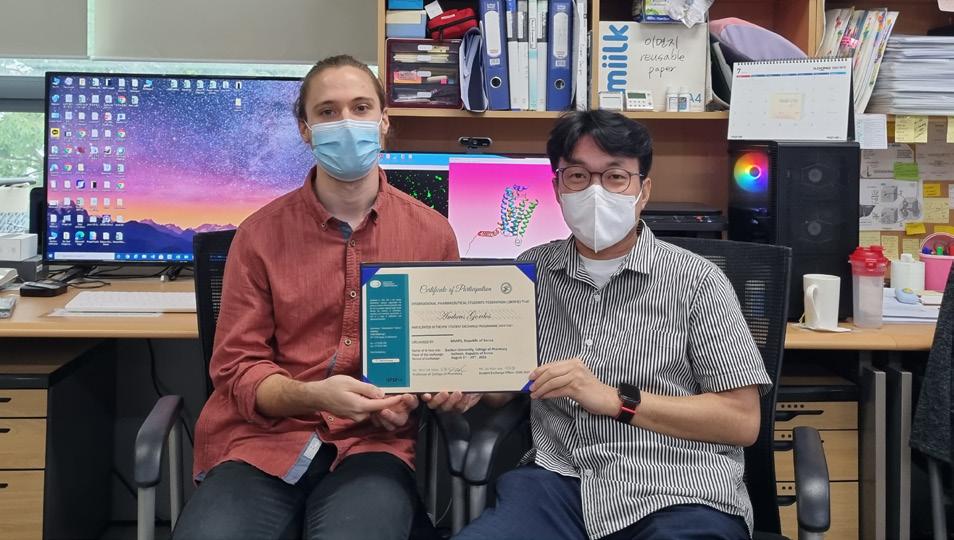
Gachon University, Incheon, Laboratory of Physiopathology
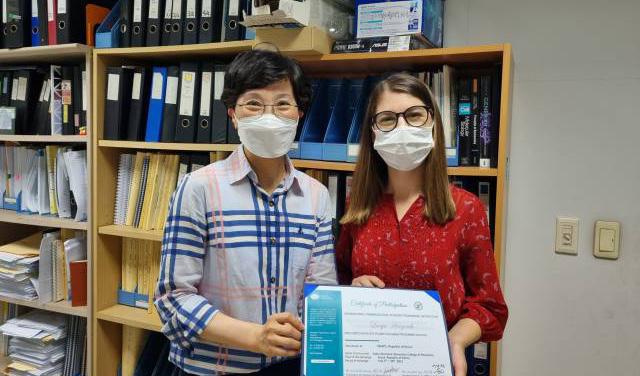
Although getting a visa was not easy due to COVID-19, it was truly an experience of a lifetime. During my two weeks of selfquarantine, KNAPS staffs prepared an online meetings with me to not let me feel bored. After the quarantine period, I had great times with KNAPS staffs by learning Korean cultures and histories. Despite of COVID-19 situation, the whole month in Korea was super eventful with a perfect mixture of learning new things, laughing, having interesting conversations, meeting fascinating people, visiting beautiful places and also tasting new delicious foods. Also, I could not have a great time without KNAPS staffs. They were very fun, friendly, and kind people who helped me find good accomodations, experience various things that are related to Korean cultures, and make great memories with good people. My experience in Korea will be remembered forever.

Ewha Womans University, Seoul, Laboratory of molecular immunology
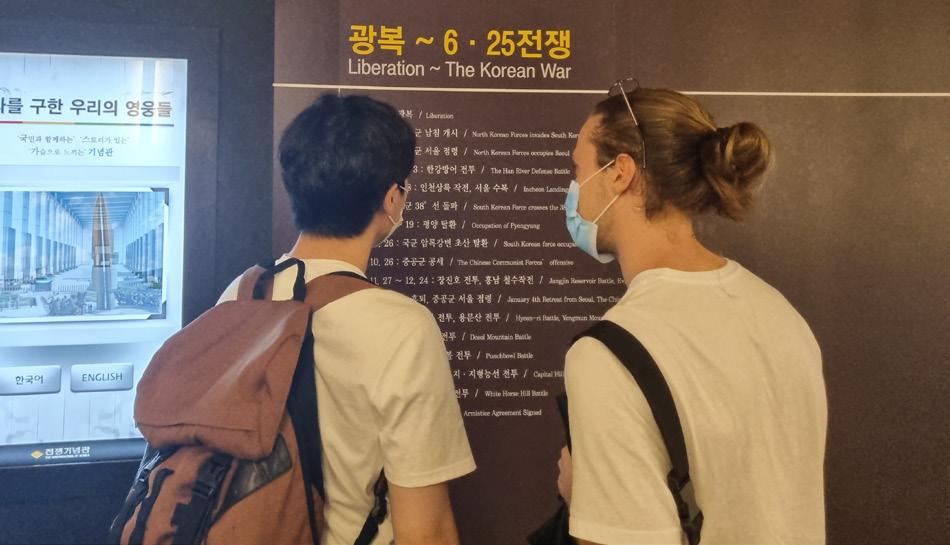
Since I’ve heard about the Student Exchange Program (SEP), it was my wish to experience it on the other side of the world. Last year when the Coronavirus pandemic hit us, this plan started to fall apart. But I didn’t give up and searched all countries on the IPSF website when I had to apply back in January. When I came across South Korea, I knew this would be my first choice because their programme description was updated this year, giving me hope that they would not cancel the SEP program. Besides that, visiting Asia has been on my wish list since forever. And I was right, choosing South Korea was the best decision I’ve ever made! Even though the COVID-19 situation was getting worse during my internship, the SEP team still tried their best. They tried to make my experience memorable and hang out as much as possible. Riding bikes along Han River while the sun was setting down, getting lost in the narrow streets of Ikseon-dong, and dressing in Korean traditional clothes made this experience so special.
I
Choi. I met my colleagues at the lab, Kim Garam, and Muna Paudel. With their help, I had a chance to observe different lab processes and to do some experiments. We always had lunch together and went to beautiful historical places. I learned a lot about Korean culture and food. I felt like I was at home because everyone was so friendly.
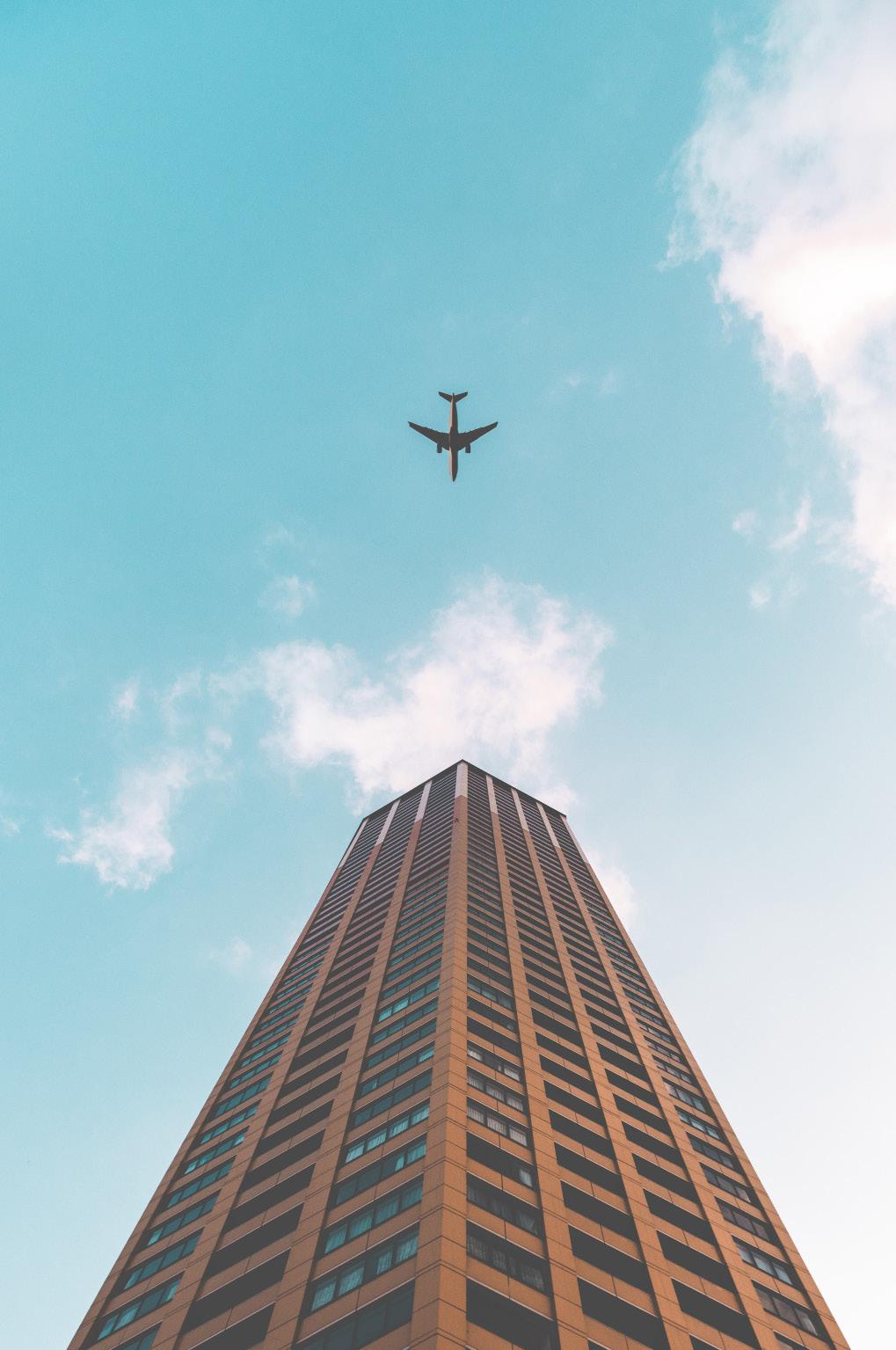
1. Contact your home SEO or LEO.
2. Ask about the pre-selection process agenda.
3. Creat an account on the SEP database.
4. When your account is accepted, fill out the application form(AF).
5. Submit the AF until the due date.
7. Check the status of your AF frequently.
● NONE - The AF has not been submitted. You can revise it anytime. When the submission is completed, the status changes from NONE to SUBMITTED.
● SUBMITTED -
● APPROVED -
Your home SEO is able to check your application but can not make any changes in it. The SEO can reject (status: SUBMITTED -> NONE) or approve it (status: SUBMITTED->APPROVED). For full approval payment(SEP fee) should be completed . Three host SEOs (from countries of your 1st, 2nd, 3rd choices) can check your AF as well. They can send your AF to the potential host pharmacist. Anyone of the three hosts can mark your AF as reserved (status: APPROVED -> RESERVED).
● RESERVED● SUCCESSFUL● UNSUCCESSFUL -
If one of the host SEOs is willing to accept you, he/she will mark your AF as RESERVED after January 15th. Then the other two hosts are blocked from reviewing your AF. After this step, a settlement is made between you and the host then final acceptance email is sent. (status: RESERVED -> PLACED) If all three SEOs show denial or you and the host can not reach an agreement, the SEOs may unreserve your AF (status: RESERVED-> NOT INTERESTED)
Your journey of the Incoming Programme has been completed! Now fill out an evaluation form in the SEP database and a certificate will be sent by email. The exchange program did not take place due to a breach of contract. Punishment will be conflicted to those who are at fault (you or the SEO).
8. If your AF is reserved, stay in contact with the host SEO, agree on the conditions of the exchange and wait for your AF to be placed on the SEP database. 9. Enjoy your time in SEP!
KNAPS/IPSF Student Exchange Officer knaps.sep@gmail.com Website of KNAPS http://www.knaps.or.kr http://www.ipsf.org/association/knaps-south-korea
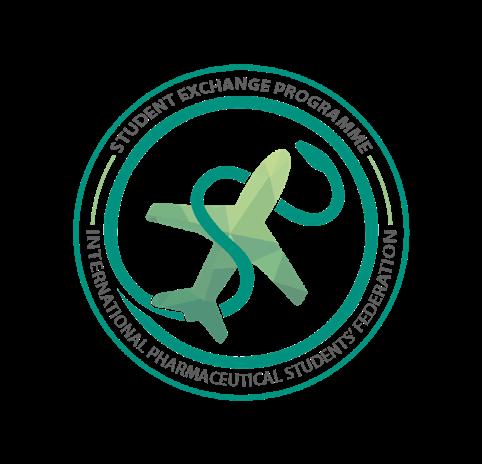
Korean National Association for Pharmaceutical Students (KNAPS) has been acting as a link to connect pharmacy students from all around the world since it was founded in 2007. KNAPS is a non-governmental, non-religious, and non-political organization, representing 37 pharmacy schools with over 2,500 students. After approved as a full member of IPSF in 2007 World Congress Taiwan, KNAPS delegates are representing Republic of Korea every year in the IPSF World Congress.
 Designed By Yebin Oh
Designed By Yebin Oh